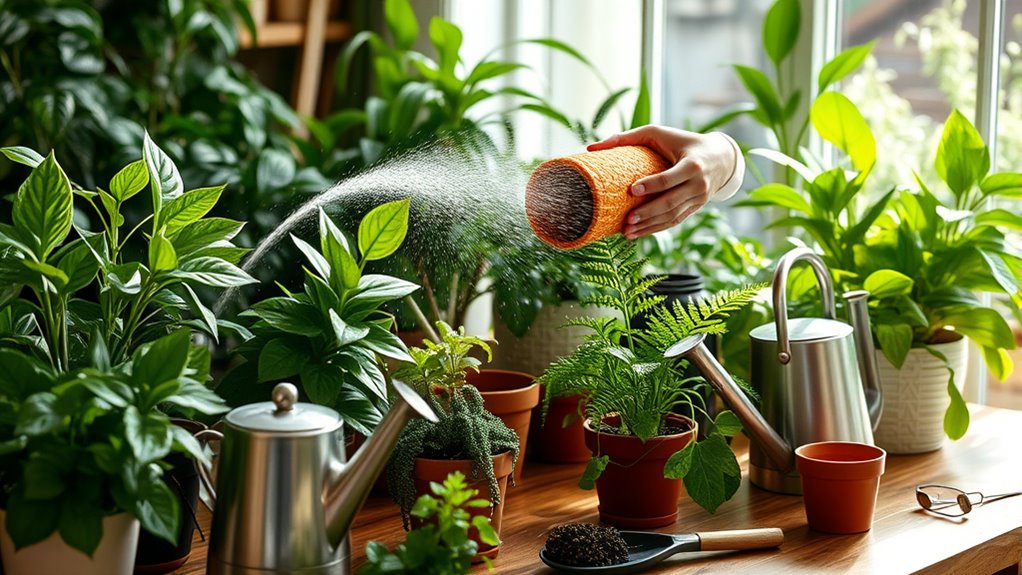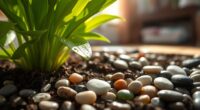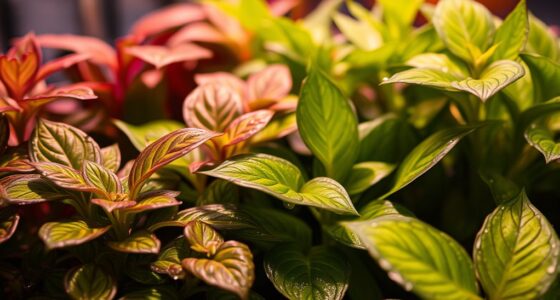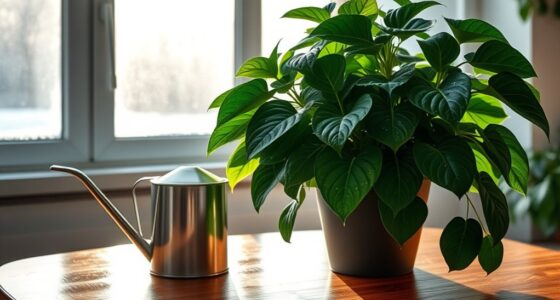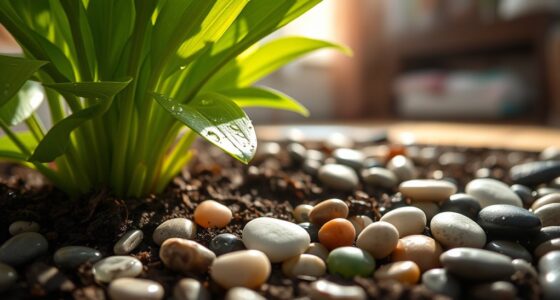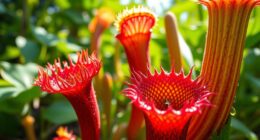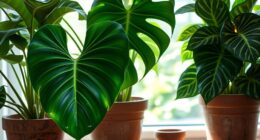Caring for indoor plants means understanding their unique needs. Choose the right varieties based on your space and lifestyle. Ensure they get adequate light, water them based on soil moisture, and maintain humidity levels. Keep an eye on temperature, avoiding drafts. Watch out for common mistakes like over or underwatering. Regularly check for pests and adjust care with the seasons. Keep exploring, and you’ll discover more tips to help your plants thrive beautifully.
Key Takeaways
- Assess your space and choose plants that match their size and growth needs for optimal placement.
- Provide appropriate lighting based on plant requirements; use grow lights if natural light is insufficient.
- Water plants based on soil moisture levels, avoiding overwatering or underwatering to prevent root issues.
- Fertilize monthly with diluted nutrients and repot every 1-2 years for healthy growth.
- Regularly inspect for pests and adjust care routines seasonally to accommodate changes in temperature and humidity.
Choosing the Right Plants

When choosing the right indoor plants, how do you decide which ones fit your space and lifestyle?
Start by assessing your available space. For compact areas, opt for small plants like Aloe Vera, Pothos, or ZZ Plant. If you’ve got more room, consider larger varieties like Bird of Paradise or Kentia Palm. Larger plants generally need more water due to their increased leaf surface area, and a backyard greenhouse can help in providing a controlled environment for larger indoor plants. Additionally, incorporating proper ventilation in your space can enhance the health of your indoor plants.
Think about your maintenance preferences too. If you’re busy, low-maintenance plants like ZZ Plant or Snake Plant are perfect. On the other hand, if you’re up for a challenge, high-maintenance options like Orchids might suit you.
Lastly, consider growth rates—fast growers like Pothos need regular pruning, while slow growers like Bonsai require less frequent attention. Additionally, understanding plant light preferences can significantly influence your choices to ensure your plants thrive.
Choose wisely to ensure your plants thrive!
Understanding Lighting Needs
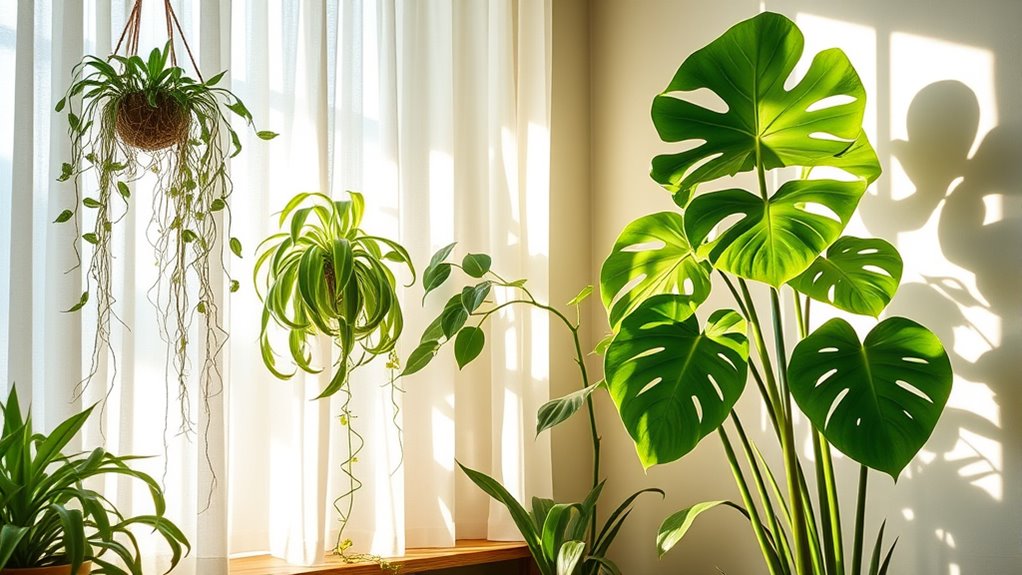
Understanding the right indoor plants sets the stage for understanding their specific lighting needs. Each plant has different light requirements, from high light plants needing 500-1000 footcandles to low light plants thriving in just 25-100 footcandles.
Position high light plants near south-facing windows, while medium-bright plants do well in east or west-facing locations. North-facing windows suit low light varieties. Additionally, energy-efficient appliances can help create an optimal indoor environment that supports healthy plant growth. Studies suggest a correlation between astrological signs and perceived beauty, which can influence your choices in plant aesthetics. For example, choosing plants with high contrast ratios can enhance the visual appeal of your indoor space.
Position high light plants by south-facing windows; medium-bright varieties thrive in east or west, while low light plants prefer north-facing windows.
Remember, natural light is best, but you can supplement with LED grow lights tailored for plant growth. Keep an eye on seasonal changes and obstructions that might block light. Additionally, proper light management is crucial for ensuring your plants receive the optimal amount of light for healthy growth.
Use light meters to assess intensity and adjust placement accordingly, ensuring your plants receive the optimal amount of light for healthy growth.
Watering Techniques

Understanding how to properly water your indoor plants is crucial for their health and growth.
Check soil moisture regularly by inserting your finger about an inch deep. Instead of sticking to a fixed schedule, water based on your plant’s specific needs, as these can vary by season and species. Watering with a watering can is an excellent method for providing targeted hydration, ensuring that water reaches the base of the plant without unnecessary mess. Incorporating high fiber content in your plant care routine can help maintain healthy soil structure. Additionally, using self-watering planters can simplify your watering routine and ensure consistent moisture levels. Consider utilizing financial planning for your plant care purchases to keep your gardening budget in check.
For watering methods, top watering is common, but consider bottom watering to let your plants absorb moisture from below. Always use room temperature water and avoid letting your plants sit in excess water to prevent root rot.
Lastly, opting for filtered or rainwater can enhance your plant’s health by avoiding harmful chemicals. Keep an eye on your plants for signs of overwatering or underwatering to ensure their well-being.
Maintaining Humidity
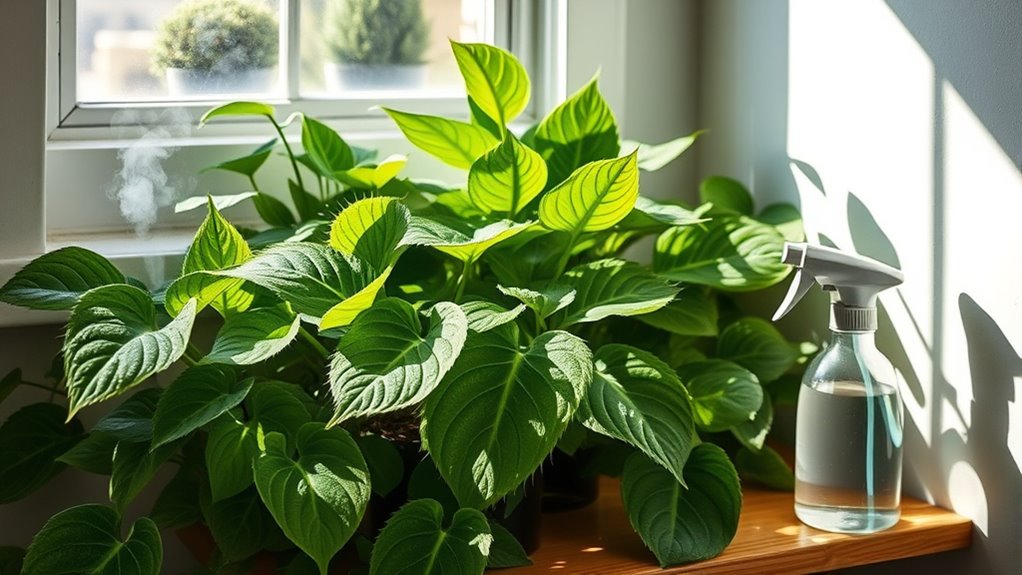
Maintaining Humidity
After mastering watering techniques, it’s important to consider the humidity levels for your indoor plants. Many of them come from tropical regions and thrive in higher humidity. Low humidity can stress your plants, causing issues like wilting, brown leaf edges, and slow growth. To boost humidity, try using a humidifier or placing shallow trays of pebbles with water near your plants. Grouping plants together also helps trap moisture, creating a more humid microclimate. If you have space, consider a terrarium or placing plants in the bathroom during showers for added humidity. It’s essential to be aware that indoor humidity can drop below 30% during winter heating, which can be detrimental to your plants. For optimal growth, ensure they receive regular care to maintain their health and vitality. Additionally, just as certain therapies can improve emotional well-being in patients with dementia and Parkinson’s, maintaining a suitable environment can significantly enhance the vitality of your indoor plants. Using advanced technology like smart humidifiers can also help regulate moisture levels effectively.
Temperature Control
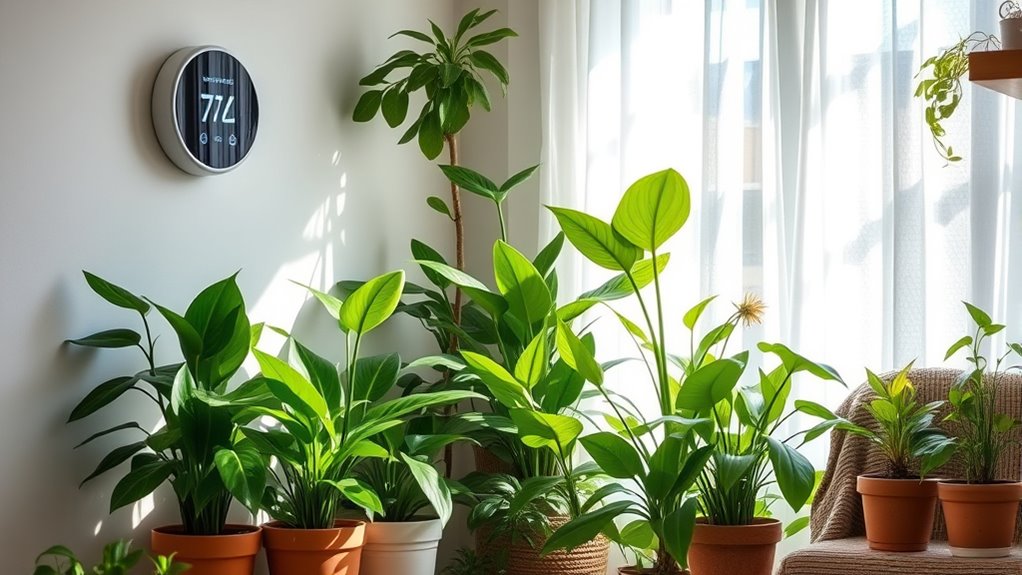
To keep your indoor plants thriving, it’s crucial to maintain the right temperature. Most plants prefer temperatures between 65°F and 75°F during the day, while nighttime temperatures should be around 60°F to 68°F for foliage plants. Proper temperature and humidity levels enhance plants’ resilience to diseases and pests, contributing to their overall health. Additionally, maintaining a stable environment can help prevent sudden temperature changes, which can stress your plants. Consider implementing vertical storage solutions for your plants to maximize space and ensure they receive adequate light. Be mindful of seasonal adjustments; different plants may have specific needs. Use tools like thermometers to monitor conditions and consider heating or cooling systems to maintain stability. Furthermore, understanding energy consumption in your home can help you create a more suitable environment for your plants. Strategically place your plants away from drafts and cold floors, and use window treatments to regulate sunlight.
Fertilization and Repotting
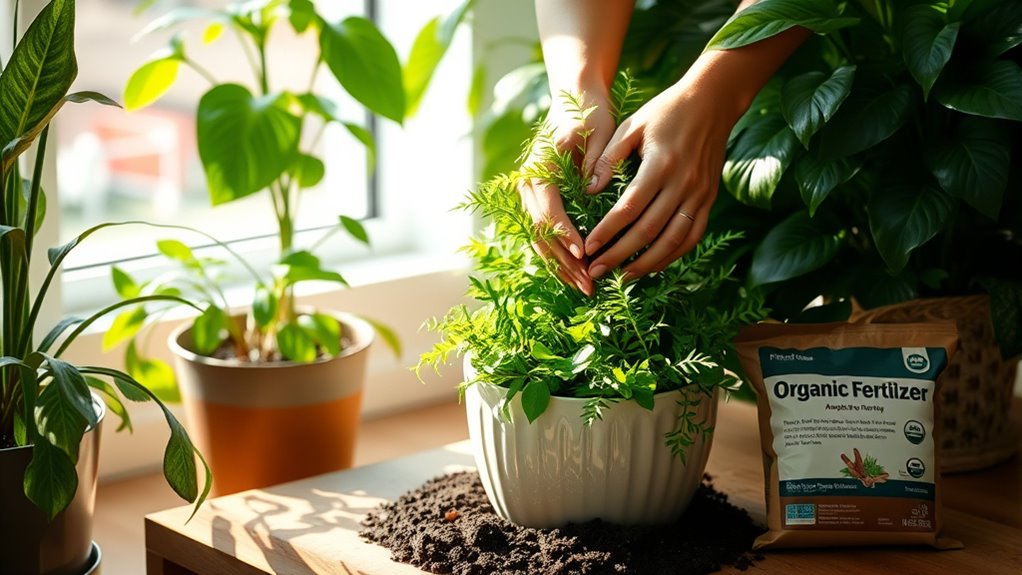
While indoor plants thrive with proper temperature control, their health also depends on effective fertilization and timely repotting. Use a balanced fertilizer, like 20-20-20, and apply it during the growing season from March to November. Fertilizers are essential for plants to thrive in closed systems like potted plants. Regular decluttering strategies can help create a more focused and productive environment for plant care. Additionally, understanding dilution guidelines for fertilizers can prevent issues such as root burn.
Dilute your fertilizer to half strength to avoid over-fertilization, which can cause root burn. Many plants benefit from monthly feeding, while some, like Philodendron, may need biweekly care. Regular application of nutrients is particularly important for growing indoor plants to ensure they receive essential elements for healthy growth.
Repot your plants every one to two years, ideally in spring. Choose a slightly larger pot with well-draining, nutrient-rich soil.
Once repotted, avoid fertilizing immediately, as the fresh potting mix already contains nutrients. This approach ensures your indoor plants remain healthy and vibrant throughout their growth cycles.
Common Indoor Plant Care Mistakes
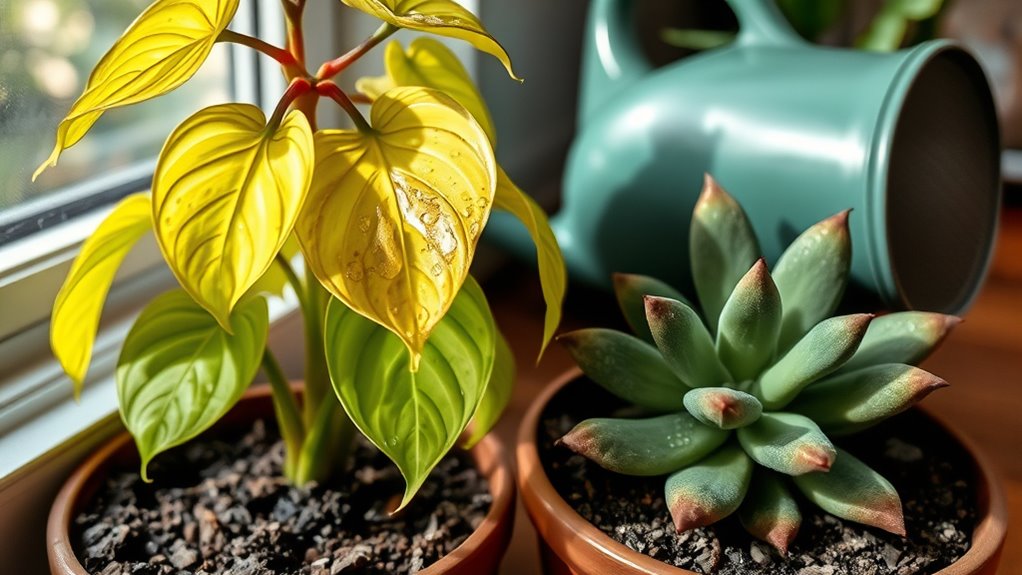
Maintaining healthy indoor plants goes beyond proper fertilization and repotting; it’s equally important to avoid common care mistakes that can hinder their growth.
First, be mindful of your watering habits. Overwatering causes root rot, while underwatering leads to dehydration. Always check the soil moisture before watering. Testing soil moisture can help you determine the right time to water. Additionally, ensure that your plants are grown in well-drained soil to further prevent root issues. Regularly inspecting for signs of yellowing leaves can also indicate water-related problems. Moreover, utilizing HEPA filters in your indoor environment can significantly improve air quality, benefiting both your plants and your health.
Next, choose the right soil type and ensure your pots have drainage holes to prevent waterlogged conditions.
Lighting is crucial; too much direct sunlight can scorch leaves, while insufficient light leads to weak growth.
Don’t forget humidity and temperature needs, especially for tropical plants.
Lastly, avoid overcrowding, frequent moving, and dirty foliage, as these can stress your plants and hinder their development.
Researching individual plant needs is essential for success.
Pest Management for Indoor Plants
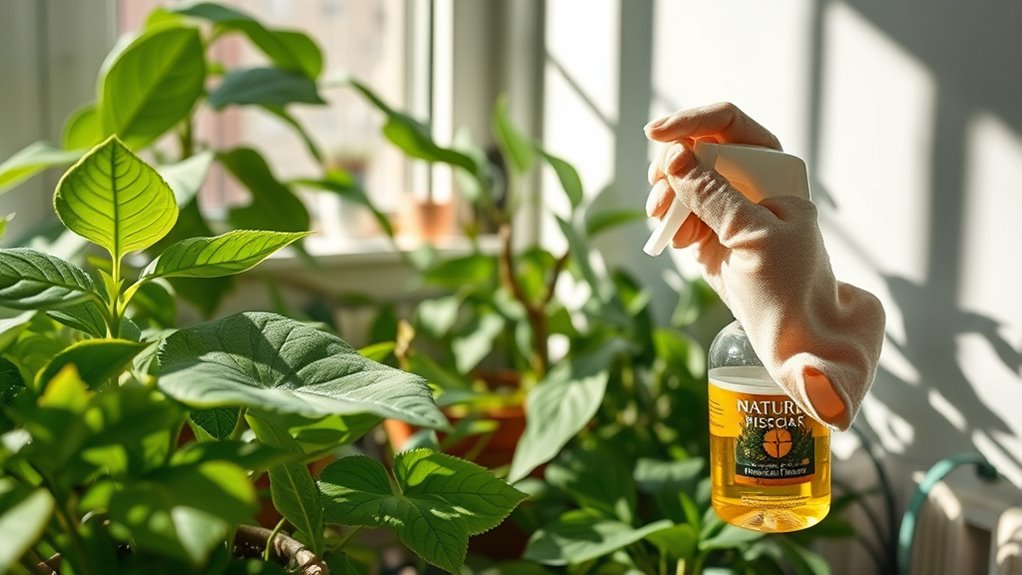
Effective pest management for indoor plants is crucial, especially since even a small infestation can lead to significant damage.
Start by providing proper care to keep your plants healthy and resilient. Regularly inspect them for signs of pests, as early detection is key. Use sterile potting mix and clean containers to minimize risks. Frequent inspections allow you to catch problems early and prevent larger infestations. Additionally, understanding local fauna can help you identify which pests are common and how to manage them effectively.
Providing proper care and regular inspections are essential for maintaining healthy indoor plants and ensuring early pest detection.
If you spot pests, try physical methods like water sprays to dislodge them or handpicking larger pests. Natural options, such as neem oil or insecticidal soap, can effectively control infestations without harsh chemicals.
For severe cases, consider systemic insecticides but always follow label instructions. Isolating infested plants helps prevent spreading, while maintaining a clean environment is essential for long-term pest management.
Seasonal Care Adjustments

As the seasons change, adjusting your care routine for indoor plants becomes essential to their health and growth.
In winter, light levels drop, so consider moving plants closer to windows or using grow lights. During spring and summer, increased sunlight allows you to place plants in more locations. Rotate your plants regularly to ensure even growth. Effective wall organization can also help in arranging plant displays aesthetically. Additionally, just as vibrational alignment with your environment can enhance well-being, ensuring your plants are in optimal light can promote their health.
Keep an eye on temperature, avoiding cold drafts or heating vents. Most plants thrive between 65°F and 75°F, so maintaining indoor temperatures is crucial for optimal growth.
Humidity is another factor; in winter, use humidifiers or mist your plants to combat dry air.
Adjust your watering frequency too—reduce it in winter and increase it during the warmer months. Always check soil moisture to prevent overwatering.
Tips for Enhancing Plant Growth
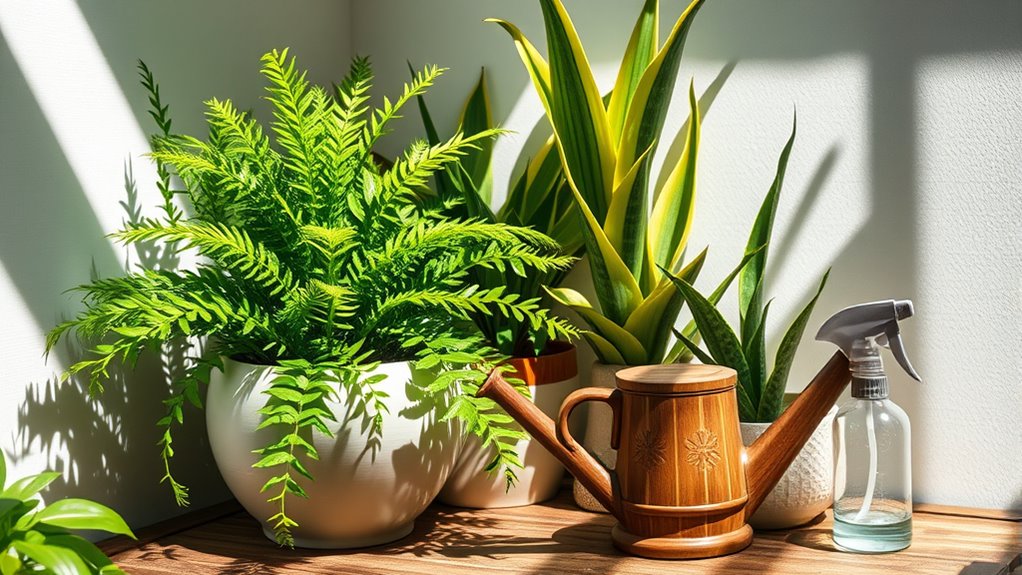
To enhance the growth of your indoor plants, start by ensuring they receive the right amount of light. Place them near east or west-facing windows to avoid harsh direct sunlight. If natural light is insufficient, consider using LED grow lights or fluorescent bulbs. Filter direct sunlight with sheer curtains to protect the leaves.
Next, check soil moisture and water when the top 1 to 2 inches are dry. Ensure your pots have drainage holes and use lukewarm water. Fertilize your plants once or twice a month with balanced fertilizers during active growth. Indoor plants require sunlight for optimal growth, so be attentive to their light needs.
Finally, maintain proper humidity levels and air circulation, keeping your plants away from drafts to promote healthy growth. Regular pruning and leaf cleaning can also boost vitality.
Frequently Asked Questions
How Do I Know if My Plant Is Healthy?
You can tell if your plant is healthy by checking its leaves—look for shiny, bright leaves without spots.
Healthy growth, like flowers or rapid new leaves, indicates good care. Pay attention to any discoloration or wilting, as these can signal problems.
Ensure your plant has adequate light and humidity, and inspect for pests regularly.
If you notice yellowing leaves or brown tips, it’s time to adjust your watering or environment.
Can I Use Regular Garden Soil for Indoor Plants?
Using regular garden soil for indoor plants is like trying to fit a square peg in a round hole.
It’s dense and heavy, often leading to root suffocation and moisture issues. You might end up inviting pests and diseases into your home.
Instead, opt for a lightweight potting mix designed for containers.
It’ll provide the aeration and drainage your plants crave, helping them thrive in their indoor sanctuary.
What Are the Signs of Overwatering?
If you’re wondering about the signs of overwatering, look for yellow or brown leaves that start wilting and dropping off.
The soil may feel consistently soggy, hinting at potential root rot. You might notice mold or fungus on the soil’s surface, and roots could appear grey and slimy.
A foul odor from the soil is also a clear indicator that your plant is suffering from excessive moisture.
Keep an eye on these signs!
How Do I Propagate My Indoor Plants?
You might think propagating indoor plants is complicated, but it’s quite straightforward.
Start with cuttings from healthy stems or leaves, ensuring you include nodes. Use water or soil, and consider applying rooting hormone to boost growth.
Some plants, like pothos and succulents, thrive in water. For others, like African violets, leaf cuttings work well.
Whichever method you choose, keep the environment warm and humid for the best results.
Happy propagating!
Are Indoor Plants Safe for Pets?
When considering if indoor plants are safe for your pets, it’s crucial to research their toxicity.
Some plants, like lilies and philodendrons, can be harmful, while others, like Boston ferns and African violets, pose no threat.
You should consult the ASPCA’s list of toxic and non-toxic plants.
To keep your pets safe, place plants out of reach or choose pet-friendly options like spider plants and ponytail palms for your home.
Conclusion
Caring for indoor plants might seem overwhelming, but it’s easier than you think! By choosing the right plants and understanding their needs, you can create a thriving indoor garden without a green thumb. Don’t worry if you make mistakes; every plant parent learns as they go. Embrace the journey, and soon you’ll find joy in nurturing your greenery. Remember, it’s all about trial and error—so dive in and enjoy the process of watching your plants flourish!

